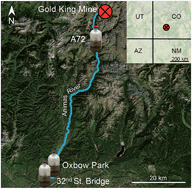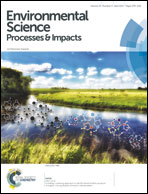Anoxia stimulates microbially catalyzed metal release from Animas River sediments†
Abstract
The Gold King Mine spill in August 2015 released 11 million liters of metal-rich mine waste to the Animas River watershed, an area that has been previously exposed to historical mining activity spanning more than a century. Although adsorption onto fluvial sediments was responsible for rapid immobilization of a significant fraction of the spill-associated metals, patterns of longer-term mobility are poorly constrained. Metals associated with river sediments collected downstream of the Gold King Mine in August 2015 exhibited distinct presence and abundance patterns linked to location and mineralogy. Simulating riverbed burial and development of anoxic conditions, sediment microcosm experiments amended with Animas River dissolved organic carbon revealed the release of specific metal pools coupled to microbial Fe- and SO42−-reduction. Results suggest that future sedimentation and burial of riverbed materials may drive longer-term changes in patterns of metal remobilization linked to anaerobic microbial metabolism, potentially driving decreases in downstream water quality. Such patterns emphasize the need for long-term water monitoring efforts in metal-impacted watersheds.



 Please wait while we load your content...
Please wait while we load your content...